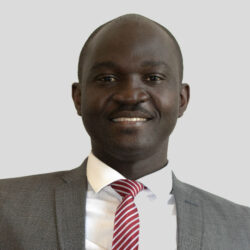
George Marbuah is a Research Fellow at SEI Headquarters and at the Stockholm Sustainable Finance Centre (SSFC). He is also part of SEI’s Development and Aid Policy Team. Marbuah and colleagues from ODI have examined the role of development finance institutions (DFIs) in promoting development in their recent research.

“DFIs are in a unique position to lead the transformation of the financial sector towards a low-carbon transition and become even more responsive to financial, socio-economic and climate crises.” said Marbuah.
An SEI report led by Marbuah published earlier this year examined the development plans of three African countries, Kenya, Ethiopia and Ghana, and the perspectives of six DFIs: Swedfund, Norfund, Finnfund, DEG, IFC and CDC (now British International Investment).
DFIs are specialized development organizations or financial actors that are usually majority-owned by national governments. They invest in private-sector projects in low- and middle-income countries to promote direct and indirect development impacts such as job creation, contribution to government revenue through taxes and sustainable economic growth while ensuring returns on investment.
In doing so, DFIs employ different strategies such as investing in domestic financial intermediaries (including banks and microfinance institutions through loans and debt financing, equity and/or the provision of additional non-financial services, including – but not limited to – technical assistance on setting standards on gender or the environment.
Q: What is the role of DFIs in developing countries in terms of achieving the SDGs?
A: Irrespective of where they invest, DFIs seek among other things to achieve development impact by ensuring that they provide additional capital and not replace existing private financing as well as non-financial services, generate decent employment and pay taxes as stipulated by the recipient country’s regulations.
By showing other investors that even risky investments are economically viable, DFIs can also have catalytic effect by bringing other investors, including DFIs, onboard to invest in unexplored opportunities. It is noteworthy that DFIs differ in terms of their mandate, size and business models, so it can be challenging to evaluate and measure their specific development impact and contribution to all the 17 SDGs. Nonetheless, shareholders in recent times have ramped up their expectations for DFIs to contribute more and respond to development objectives and global challenges and initiatives such as the SDGs and climate change (Paris Agreement).
The evidence we have observed shows that many DFIs are responding positively to these expectations and developing countries are the main beneficiaries of these efforts. Specific examples include Swedfund (Sweden), FMO (the Netherlands) and Proparco (France) explicitly demonstrating commitment that their investments contribute toward SDG 13 (climate action), other SDGs and the Paris Agreement in general. Several members of the European DFI association (EDFI) have either stopped or committed to stopping lending to fossil fuel projects by 2030. Notable examples include the European Investment Bank (EIB), IFU (Danish DFI) and Swedfund, which has invested in only renewable energy since 2014.
Q: Are there potential obstacles for DFIs contributing to national development goals?
A: Traditionally, most DFIs do not engage directly with national governments, a position we tried to question in our research with the aim of suggesting that there could be value in doing so, thereby taking advantage of additional commercial opportunities and enhancing the development impact of DFIs. We try to understand the role of DFIs regarding sustainable development that aligns with national development objectives or priorities that emphasize the SDGs in Ethiopia, Ghana and Kenya and interaction with the six selected DFIs for their perspectives on this issue.
Among other things, our interaction with the sampled DFIs suggests that country-level development plans do not necessarily drive their investments and in certain cases, these plans may present obstacles to investment. These barriers also vary from case to case. To the extent that DFIs differ in mandate, size and resources, including capacity, several of them are constrained by lack of capacity and in-country office presence in all the jurisdictions they invest. It takes time and expertise to review and synthesize national development plans whose quality is often questioned by many DFIs. Most small bilateral DFIs would rather respond to their shareholder needs by creating global sector and instrument strategies and not by specific countries, with the exception of large multilateral DFIs such as the IFC of the World Bank Group.
Additionally, national strategic documents may lack detailed data that could be used to identify existing investment gaps. Certain countries are not clear about their consideration of the SDGs, a premise many bilateral DFIs use for their investment decisions. Of the countries reviewed, only Ethiopia was explicit in the mention of the SDGs in its development plan, while Ghana and Kenya did it implicitly.
Moreover, the national development goals may not fit with the DFIs’ strategies and their willingness to distribute their resources for which they want to be accountable. A risky business climate due to an unstable political administration and governance with weak institutions may also be a hindrance depending on the DFI’s structure, credibility and historical position.
According to several DFIs, since the continuity of government programmes and policies is uncertain, national development plans should not be the major determinant of DFI investment decisions. Instead, DFIs should invest according to their own strategies and engage in targeted dialogue with governments and their plans where necessary. These discussions should focus on finding value in opportunities that complement those that exist in the private sector, with the aim of increasing development impact. In particular, DFIs expect that such targeted interaction should lead to improving the business and regulatory environments to protect their strategic investments, resulting in enhanced impact.
Q: What measures can DFIs take to align their investments with the countries’ development plans?
A: Among our key findings is that most DFIs do not significantly consider national development plans in their operations. To the largest extent, investment decisions are driven by internal objectives and strategies. At the same time, DFIs do acknowledge that there may be opportunities to engage more with national governments, albeit in a limited and targeted way. We suggest the following four steps DFIs can undertake to realize the benefits of these types of engagements:
Step 1: policy documents to identify strategic sectors besides private sector opportunities.
Step 2: Compare strategic sectors with current investment activities, including country investment portfolios, to understand where and how they fit together. This step will help DFIs determine where funding is lacking. The caveat here is that not all DFIs have the capacity and resources to tailor their investment strategies to each country’s priority sectors. While larger DFIs with more resources could undertake these activities, smaller ones may allocate their limited resources in a more strategic way, such as prioritizing where they invest the most.
Step 3: Engage with key stakeholders to secure support or buy-in for identified sectors and aligned sector investment strategies. They could be business associations and industry players, other private investors or DFIs and relevant government agencies.
Step 4: Scope out opportunities for feasible investment in target priority sectors compatible with their overall strategies.
Q: SweDev aims to connect development researchers across Sweden to strengthen collaboration with practitioners. What are the key research findings that you would like to share with our community?
A: This is an important study to share with the SweDev network. The findings could be useful to better understand what DFIs are doing and can improve. The implications can also guide other actors in the development sector on how to align their investments or activities with localized needs that are likely more impactful. The four steps mentioned above can be quite useful in such an exercise.
The study also serves to correct certain misconceptions about DFIs and how they operate and recognize that we need to start discussions with governments by moving away from traditional approaches and looking at the bigger picture. Perhaps the question we may want to answer in the future resolves around the role of government (and policies) and other actors in making DFI investments even more impactful in recipient countries.
Written by Roksana Rotter, Research Intern and Ylva Rylander, Communications Officer within SweDev at SEI. Edited by George Marbuah and Vivian Tse at SEI.

Recent Comments